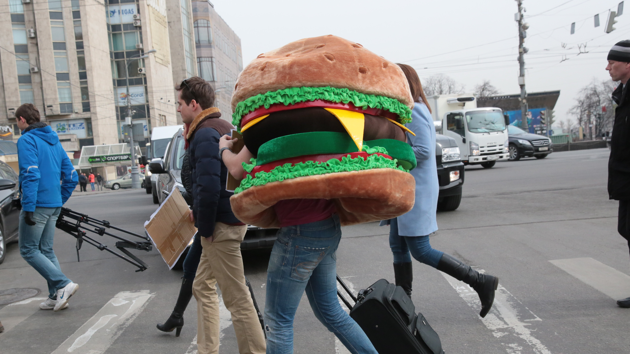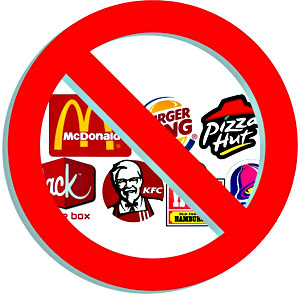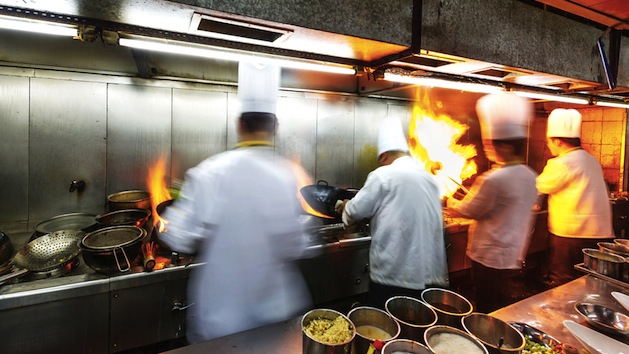
<a href="http://www.shutterstock.com/pic-142846204/stock-photo-chef-in-restaurant-kitchen-at-stove-with-pan-doing-flambe-on-food.html?src=iwIvvsV7KoUOT6sDx_AzaA-1-21">hxdyl </a>/Shutterstock
It isn’t just fast-food empires that rely on a low-paid, disempowered, and quite-often impoverished workforce. As a stomach-turning new report (PDF viewable here) from the Economic Policy Institute shows, the entire restaurant industry hides a dirty little labor secret under the tasteful lighting of the dining room.
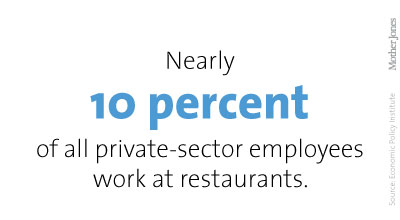
Here are some highlights:
• The restaurant industry is a massive and growing source of employment. It accounts for more than 9 percent of US private-sector jobs—up from a little more than 7 percent in 1990. That’s nearly a 30 percent gain.
• The industry’s wages have stagnated at an extremely low level. Restaurant workers’ median wage stands at $10 per hour, tips included—and hasn’t budged, in inflation-adjusted terms, since 2000. For nonrestaurant US workers, the median hourly wage is $18. That means the median restaurant worker makes 44 percent less than other workers. Benefits are also rare—just 14.4 percent of restaurant workers have employer-sponsored health insurance and 8.4 percent have pensions, vs. 48.7 percent and 41.8 percent, respectively, for other workers
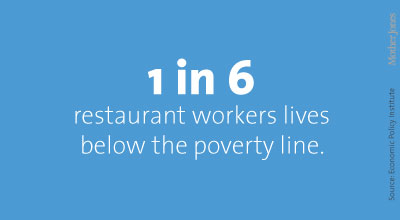
• Unionization rates are minuscule. Presumably, it would be more difficult to keep wages throttled at such a low level if restaurant workers could bargain collectively. But just 1.8 percent of restaurant workers belong to unions, about one-seventh of the rate for nonrestaurant workers. Restaurant workers who do belong to unions are much more likely to have benefits than their nonunion peers.
• As a result, the people who prepare and serve you food are pretty likely to live in poverty. The overall poverty rate stands at 6.3 percent. For restaurant workers, the rate is 16.7 percent. For families, researchers often look at twice the poverty threshold as proxy for what it takes to make ends meet, EPI reports. More than 40 percent of restaurant workers live below twice the poverty line—that’s double the rate of nonrestaurant workers.
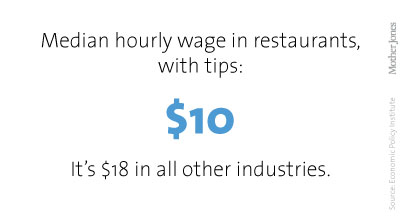
• Opportunity for advancement is pretty limited. I was surprised to learn that for every single occupation with restaurants—from dishwashers to chefs to managers—the median hourly wage is much less than the national average of $18. The highest paid occupation is manager, with a median hourly wage of $15.42. The lowest is “cashiers and counter attendants” (median wage: $8.23), while the most prevalent of restaurant workers, waiters and waitresses, who make up nearly a quarter of the industry’s workforce, make a median wage of just $10.15. The one that has gained the most glory in recent years, “chefs and head cooks,” offers a median wage of just $12.34.
• Industry occupations are highly skewed along gender and race lines. Higher-paid occupations are more likely to be held by men—chefs, cooks, and managers, for example, are 86 percent, 73 percent, and 53 percent male, respectively. Lower-paid positions tend to be dominated by women: for example, host and hostess (84.9 percent female), cashiers and counter attendants (75.1 percent), and waiters and waitresses (70.8 percent). I took up this topic in a piece on the vexed gender politics of culinary prestige last year. Meanwhile, “blacks are disproportionately likely to be cashiers/counter attendants, the lowest-paid occupation in the industry,” while “Hispanics are disproportionately likely to be dishwashers, dining room attendants, or cooks, also relatively low-paid occupations,” the report found.

• Restaurants lean heavily on the most disempowered workers of all—undocumented immigrants. Overall, 15.7 percent of US restaurant workers are undocumented, nearly twice the rate for nonrestaurant sectors. Fully a third of dishwashers, nearly 30 percent of nonchef cooks, and more than a quarter of bussers are undocumented, the report found. So a huge swath of the people who feed you pay payroll taxes and sales taxes yet don’t receive the rights of citizenship.
Thus you can’t opt out of supporting deplorable labor conditions for the people who feed you simply by refusing to pass through the Golden Arches or to enter the Burger King’s realm.
So what can you do? One thing is to seek out restaurants that explicitly pay their workers a living wage. Two I can think of offhand: Austin’s Black Star Co-op, a cooperatively owned gastro-pub that’s managed by a “workers assembly” as a “democratic self-managed workplace.” Another is Chapel Hill’s excellent Vimala’s Curryblossom Cafe. I’d love to hear about more examples in comments.
But these examples are vanishingly rare. The only real solution to the industry’s bottom-feeding labor practices are legislative, the EPI report makes clear. That means reforms like a much higher minimum wage and a path to legal status for undocumented workers. Anyone who wants to learn more about working conditions in our nation’s eateries should read Saru Jayaraman’s outstanding 2013 book Behind the Kitchen Door. (Read the Mother Jones review here.)
And just for fun, here’s the Mother Jones fast-food wage calculator, which will give you a sense of what some workers are up against:



